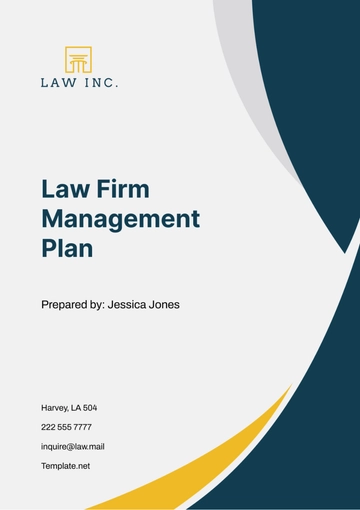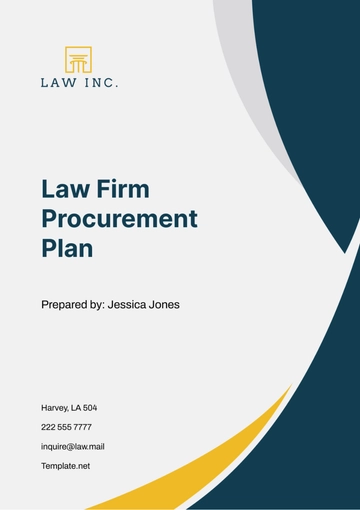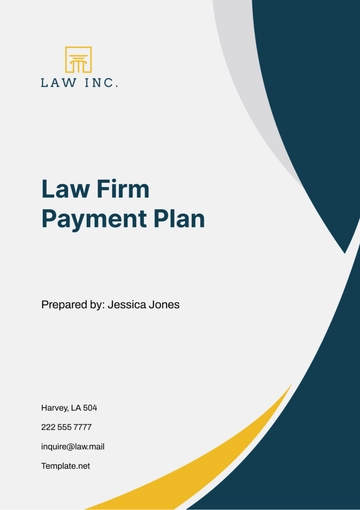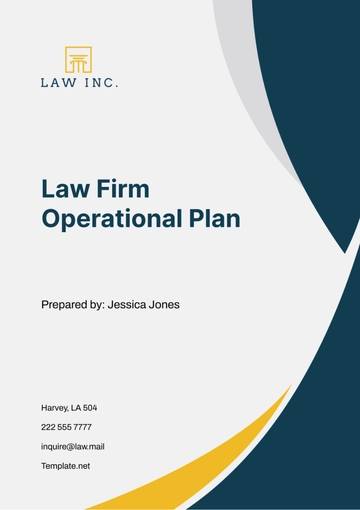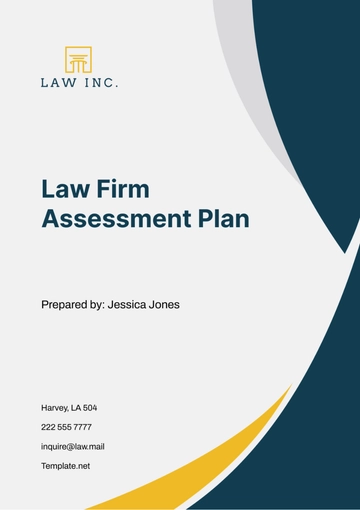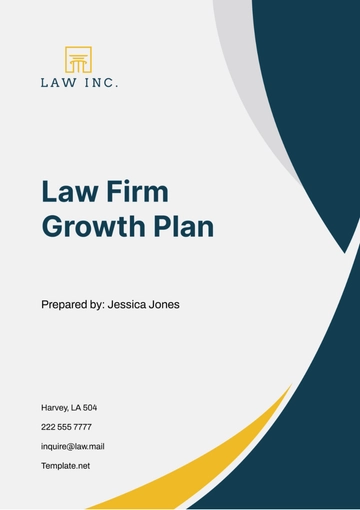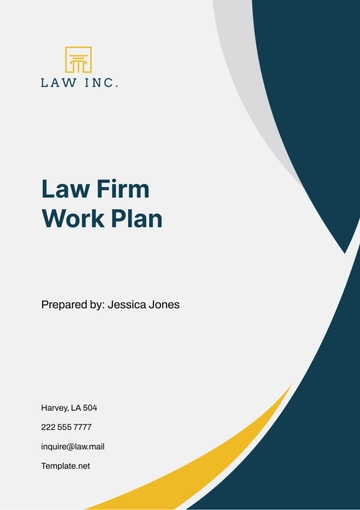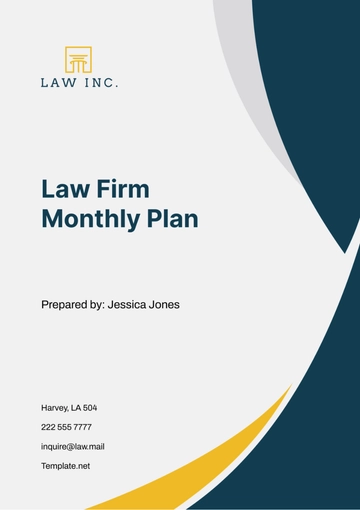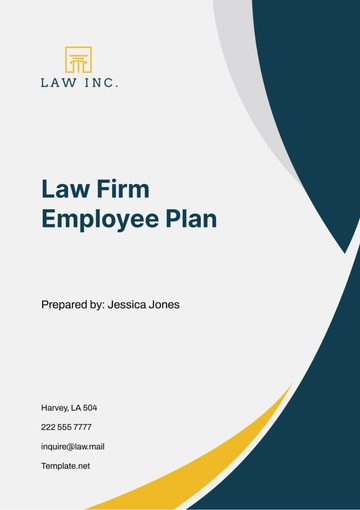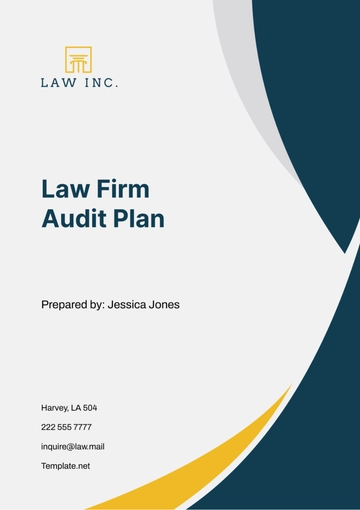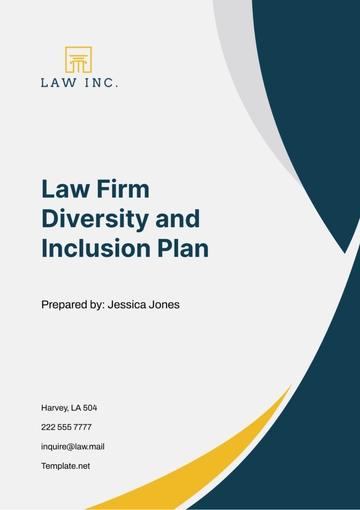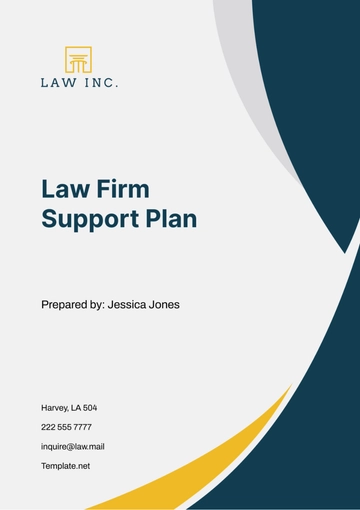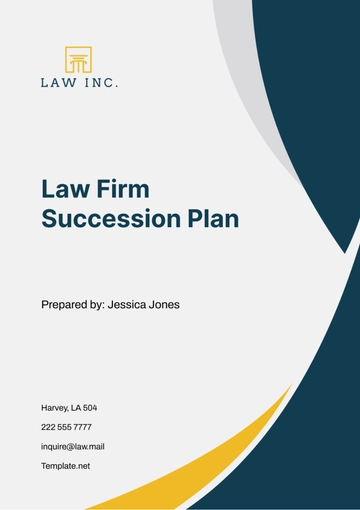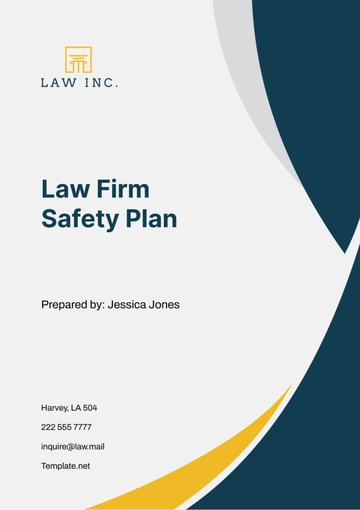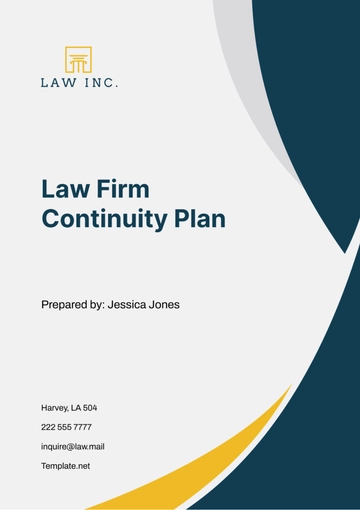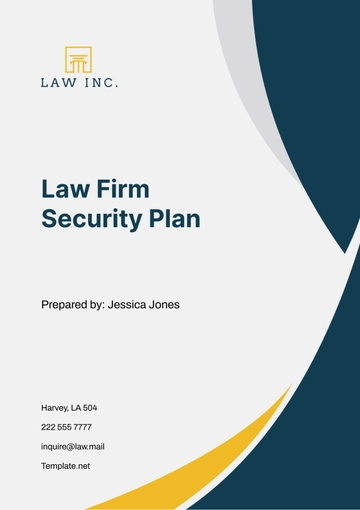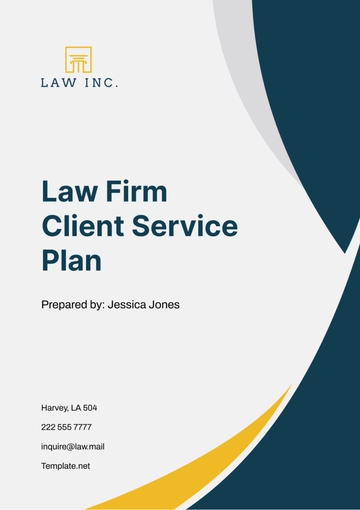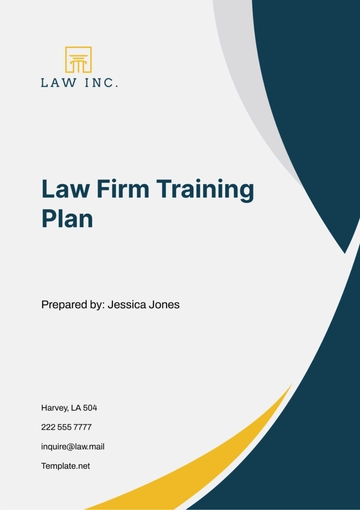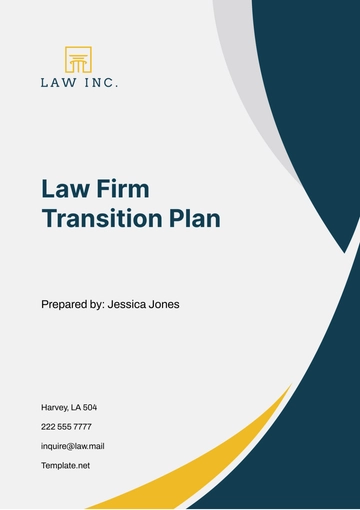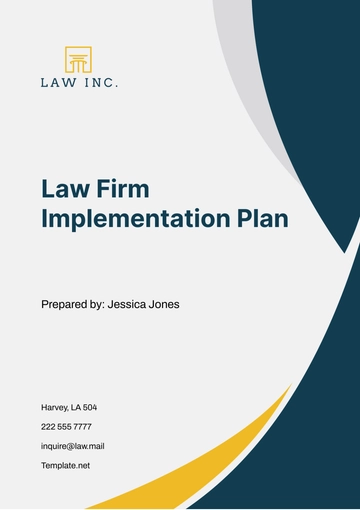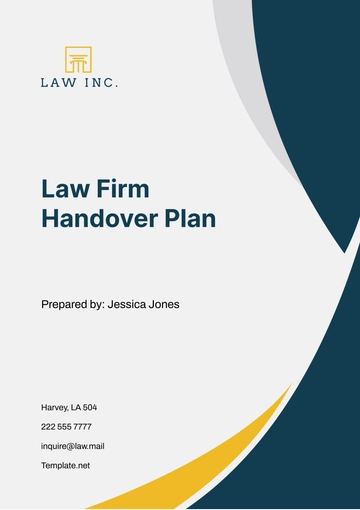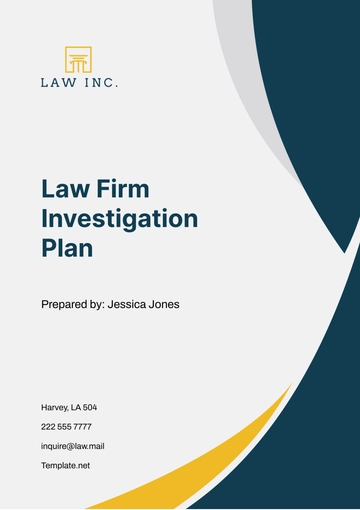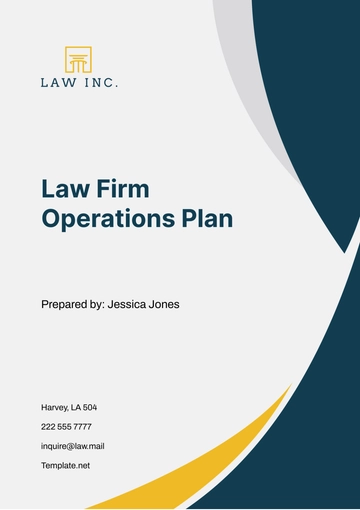Free Law Firm Transition Plan
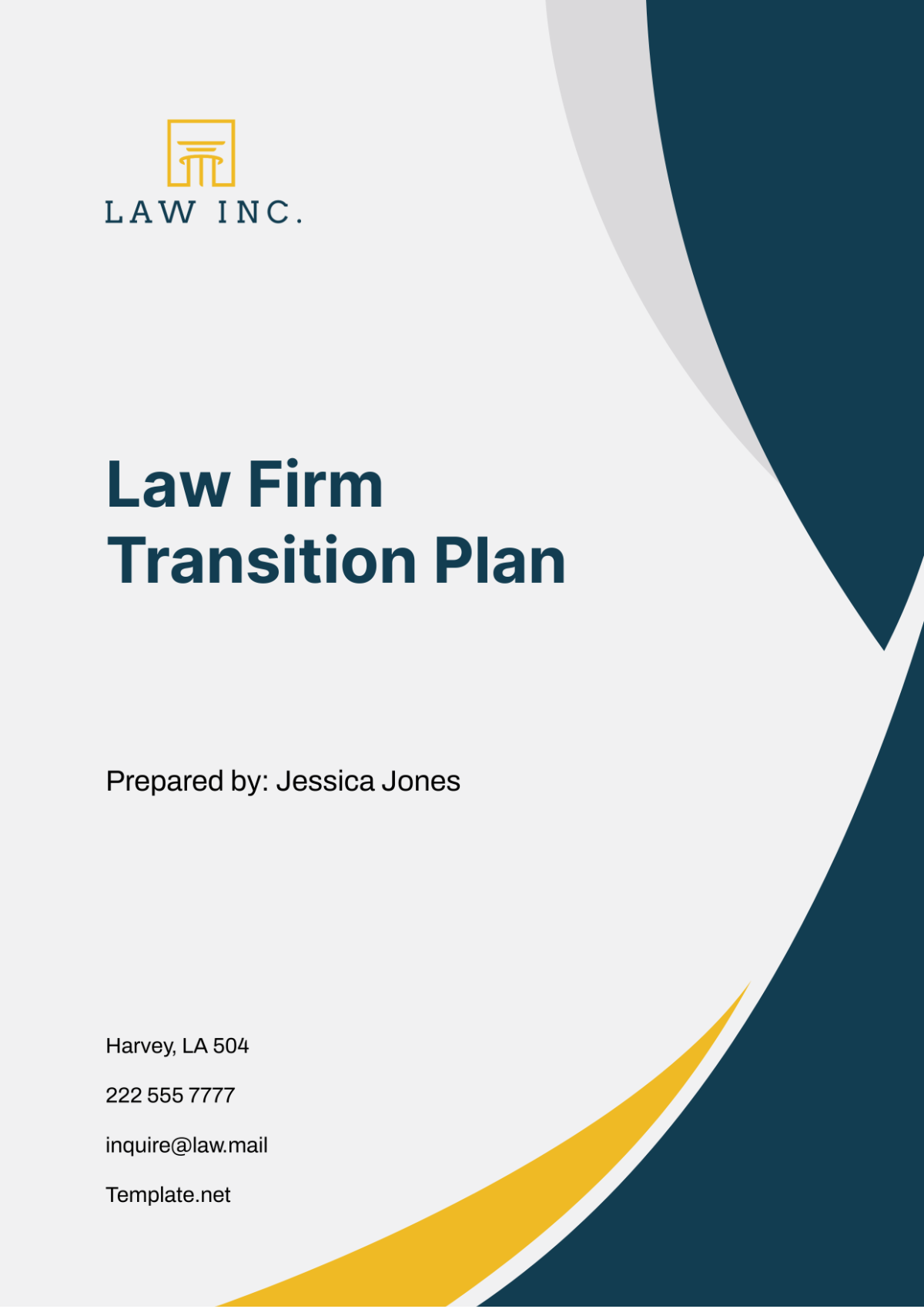
I. Introduction
The Transition Plan outlines the strategic steps and considerations necessary to navigate significant changes within [Your Company Name]. Whether undergoing leadership transitions, mergers, acquisitions, or structural reorganizations, this plan aims to ensure a smooth and seamless transition while maintaining operational continuity and preserving client satisfaction.
II. Objectives
The objectives of the transition plan for [Your Company Name] are outlined below, providing a clear roadmap for navigating significant changes and ensuring operational continuity. These objectives are designed to facilitate smooth leadership transitions, optimize operational processes, and preserve client satisfaction throughout the transition period.
Leadership Continuity: Facilitate a smooth transition of leadership roles and responsibilities to maintain stability and strategic direction within the firm.
Operational Integration: Seamlessly integrate systems, processes, and personnel to optimize efficiency and effectiveness post-transition.
Client Retention: Preserve client relationships and satisfaction by minimizing disruptions and maintaining the quality of service throughout the transition.
Cultural Alignment: Foster a cohesive and unified organizational culture that supports collaboration, innovation, and shared values across all stakeholders.
By adhering to these objectives, the firm aims to foster organizational stability, enhance stakeholder confidence, and position itself for long-term success in the legal industry.
III. Transition Strategy
A. Assessment Phase:
Leadership Assessment:
Evaluate the skills, experience, and leadership qualities of current leaders to identify potential gaps or areas for development.
Assess leadership succession plans and identify suitable candidates for key leadership roles within the firm.
Conduct stakeholder interviews and 360-degree assessments to gather feedback on leadership effectiveness and areas for improvement.
Organizational Culture Evaluation:
Conduct surveys or focus groups to assess organizational culture, values, and norms, identifying strengths, weaknesses, and areas for alignment.
Analyze communication channels, decision-making processes, and employee engagement levels to gauge cultural health and cohesion.
Assess the firm's readiness for change, including staff members' attitudes, beliefs, and receptiveness to organizational transformation.
B. Planning Phase:
Transition Plan Development:
Establish a dedicated transition team or task force responsible for developing and executing the transition plan.
Define clear objectives, milestones, and deliverables for each phase of the transition, ensuring alignment with firm goals and priorities.
Develop communication protocols and channels to facilitate transparent and timely information sharing with staff, clients, and stakeholders.
Risk Assessment and Mitigation:
Identify potential risks and vulnerabilities associated with the transition, including leadership changes, operational disruptions, and client retention challenges.
Assess the likelihood and potential impact of each risk, prioritizing those with the highest probability and severity.
Develop mitigation strategies and contingency plans to address identified risks, ensuring readiness to respond effectively to unforeseen events or setbacks.
Resource Allocation:
Allocate human, financial, and technological resources to support the execution of the transition plan effectively.
Identify key stakeholders and assign roles and responsibilities for each phase of the transition, clarifying accountabilities and reporting structures.
Establish performance metrics and benchmarks to track progress, measure success, and ensure accountability throughout the transition process.
C. Execution Phase:
Leadership Transitions:
Facilitate smooth leadership transitions by providing outgoing and incoming leaders with clear expectations, support, and resources.
Conduct leadership onboarding sessions and mentorship programs to help incoming leaders acclimate to their new roles and responsibilities.
Communicate leadership changes internally and externally, emphasizing continuity, stability, and commitment to client service.
Operational Restructuring:
Implement changes to organizational structure, reporting lines, and workflow processes to optimize efficiency and effectiveness.
Coordinate with relevant stakeholders to ensure seamless integration of systems, technologies, and personnel across departments and practice areas.
Provide training and support to staff members to ensure they are equipped to adapt to new roles, responsibilities, and operational procedures.
Client Communication and Engagement:
Communicate proactively with clients about the transition, reassuring them of continued commitment to their needs and maintaining the quality of service.
Assign dedicated client relationship managers to address any concerns or questions and ensure a smooth transition of client relationships.
Solicit feedback from clients throughout the transition process, incorporating their input to refine service offerings and enhance client satisfaction.
Staff Training and Support:
Provide comprehensive training programs and resources to staff members to equip them with the skills, knowledge, and tools needed to navigate the transition successfully.
Offer ongoing support, guidance, and coaching to staff members to help them adapt to changes and overcome challenges during the transition.
Foster a culture of resilience, collaboration, and innovation, encouraging staff members to embrace change as an opportunity for growth and development.
D. Evaluation Phase:
Progress Monitoring and Performance Evaluation:
Monitor progress and performance against predefined metrics and key performance indicators (KPIs) to assess the effectiveness and impact of the transition.
Conduct regular reviews and check-ins to track milestones, identify bottlenecks, and address any issues or challenges that may arise.
Adjust strategies, priorities, and resource allocations as needed to ensure alignment with transition objectives and desired outcomes.
Stakeholder Feedback Solicitation:
Solicit feedback from staff, clients, and stakeholders to gauge satisfaction levels, identify areas for improvement, and inform future decision-making.
Conduct surveys, focus groups, or one-on-one interviews to gather qualitative and quantitative feedback on the transition process and its impact.
Analyze feedback data to identify trends, patterns, and actionable insights for enhancing organizational effectiveness and stakeholder engagement.
Post-Transition Reviews and Lessons Learned:
Facilitate post-transition reviews and debriefing sessions to capture insights, best practices, and areas for improvement for future transitions.
Document key learnings, successes, and challenges encountered during the transition process, ensuring knowledge transfer and continuous improvement.
Develop a transition playbook or toolkit based on lessons learned, providing guidance and resources to support future transition efforts within the firm.
IV. Key Initiatives
Leadership Transition:
Identify and onboard new leadership candidates, ensuring a smooth transition of responsibilities and strategic direction.
Provide mentorship and support to incoming leaders to facilitate their integration into the firm's culture and operations.
Operational Integration:
Assess existing systems, processes, and workflows to identify opportunities for alignment, standardization, and efficiency improvements.
Implement technology solutions and training programs to support seamless integration and collaboration across teams and departments.
Client Retention:
Communicate proactively with clients about the transition, assuring them of continued commitment to their needs and maintaining the quality of service.
Assign dedicated client relationship managers to address any concerns or questions and ensure a smooth transition of client relationships.
Cultural Alignment:
Foster open communication, transparency, and inclusivity to build trust and engagement among staff members throughout the transition process.
Organize team-building activities, workshops, and town hall meetings to reinforce shared values, goals, and expectations post-transition.
V. Timeline
The timeline table below outlines key phases and activities in the transition plan for [Your Company Name], providing a structured overview of the implementation timeline and milestones.
Phase | Activities | Timeline |
|---|---|---|
Assessment Phase | Leadership Assessment | Month 1 |
Organizational Culture Evaluation | Month 2 | |
Planning Phase | Transition Plan Development | Months 2-3 |
Risk Assessment and Mitigation | Month 3 | |
Resource Allocation | Month 4 | |
Execution Phase | Leadership Transitions | Months 5-6 |
Operational Restructuring | Months 6-8 | |
Client Communication and Engagement | Ongoing | |
Staff Training and Support | Ongoing | |
Evaluation Phase | Progress Monitoring and Performance Evaluation | Ongoing |
Stakeholder Feedback Solicitation | Months 9-10 | |
Post-transition Reviews and Lessons Learned | Month 11 |
VI. Resources
The successful execution of the Transition Plan relies on the effective allocation and utilization of various resources. Here are the resources utilized by [Your Company Name]:
Personnel Resources: Experienced staff members, including lawyers, paralegals, administrative assistants, and support staff, who contribute their skills, knowledge, and expertise to facilitate the transition.
Financial Resources: Budget allocations for transition-related expenses, including consultant fees, technology upgrades, training programs, and contingency funds to address unforeseen costs.
Technology Resources: Software solutions such as project management tools, communication platforms, and document management systems to streamline workflows, enhance collaboration, and support operational efficiency during the transition.
Consulting Resources: External consultants or advisors specializing in organizational change management, leadership transition, or legal industry best practices, providing expertise and guidance to support the firm throughout the transition process.
Training and Development Resources: Training programs, workshops, and professional development resources to equip staff members with the skills, knowledge, and tools needed to adapt to new roles, responsibilities, and operational procedures during the transition.
VII. Conclusion
The Transition Plan provides a structured framework for navigating significant changes within [Your Company Name], ensuring continuity, stability, and strategic alignment throughout the transition process. By adhering to the outlined strategy and leveraging available resources effectively, the firm can navigate transitions successfully and position itself for long-term success in a dynamic and evolving legal landscape.
- 100% Customizable, free editor
- Access 1 Million+ Templates, photo’s & graphics
- Download or share as a template
- Click and replace photos, graphics, text, backgrounds
- Resize, crop, AI write & more
- Access advanced editor
Ensure smooth transitions with Template.net's Law Firm Transition Plan Template. Editable in our AI Editor Tool, this customizable template provides a structured format for outlining tasks, timelines, and responsibilities during transitions such as mergers, acquisitions, or leadership changes in your law firm. Enhance continuity, minimize disruptions, and facilitate effective transitions with ease!
You may also like
- Finance Plan
- Construction Plan
- Sales Plan
- Development Plan
- Career Plan
- Budget Plan
- HR Plan
- Education Plan
- Transition Plan
- Work Plan
- Training Plan
- Communication Plan
- Operation Plan
- Health And Safety Plan
- Strategy Plan
- Professional Development Plan
- Advertising Plan
- Risk Management Plan
- Restaurant Plan
- School Plan
- Nursing Home Patient Care Plan
- Nursing Care Plan
- Plan Event
- Startup Plan
- Social Media Plan
- Staffing Plan
- Annual Plan
- Content Plan
- Payment Plan
- Implementation Plan
- Hotel Plan
- Workout Plan
- Accounting Plan
- Campaign Plan
- Essay Plan
- 30 60 90 Day Plan
- Research Plan
- Recruitment Plan
- 90 Day Plan
- Quarterly Plan
- Emergency Plan
- 5 Year Plan
- Gym Plan
- Personal Plan
- IT and Software Plan
- Treatment Plan
- Real Estate Plan
- Law Firm Plan
- Healthcare Plan
- Improvement Plan
- Media Plan
- 5 Year Business Plan
- Learning Plan
- Marketing Campaign Plan
- Travel Agency Plan
- Cleaning Services Plan
- Interior Design Plan
- Performance Plan
- PR Plan
- Birth Plan
- Life Plan
- SEO Plan
- Disaster Recovery Plan
- Continuity Plan
- Launch Plan
- Legal Plan
- Behavior Plan
- Performance Improvement Plan
- Salon Plan
- Security Plan
- Security Management Plan
- Employee Development Plan
- Quality Plan
- Service Improvement Plan
- Growth Plan
- Incident Response Plan
- Basketball Plan
- Emergency Action Plan
- Product Launch Plan
- Spa Plan
- Employee Training Plan
- Data Analysis Plan
- Employee Action Plan
- Territory Plan
- Audit Plan
- Classroom Plan
- Activity Plan
- Parenting Plan
- Care Plan
- Project Execution Plan
- Exercise Plan
- Internship Plan
- Software Development Plan
- Continuous Improvement Plan
- Leave Plan
- 90 Day Sales Plan
- Advertising Agency Plan
- Employee Transition Plan
- Smart Action Plan
- Workplace Safety Plan
- Behavior Change Plan
- Contingency Plan
- Continuity of Operations Plan
- Health Plan
- Quality Control Plan
- Self Plan
- Sports Development Plan
- Change Management Plan
- Ecommerce Plan
- Personal Financial Plan
- Process Improvement Plan
- 30-60-90 Day Sales Plan
- Crisis Management Plan
- Engagement Plan
- Execution Plan
- Pandemic Plan
- Quality Assurance Plan
- Service Continuity Plan
- Agile Project Plan
- Fundraising Plan
- Job Transition Plan
- Asset Maintenance Plan
- Maintenance Plan
- Software Test Plan
- Staff Training and Development Plan
- 3 Year Plan
- Brand Activation Plan
- Release Plan
- Resource Plan
- Risk Mitigation Plan
- Teacher Plan
- 30 60 90 Day Plan for New Manager
- Food Safety Plan
- Food Truck Plan
- Hiring Plan
- Quality Management Plan
- Wellness Plan
- Behavior Intervention Plan
- Bonus Plan
- Investment Plan
- Maternity Leave Plan
- Pandemic Response Plan
- Succession Planning
- Coaching Plan
- Configuration Management Plan
- Remote Work Plan
- Self Care Plan
- Teaching Plan
- 100-Day Plan
- HACCP Plan
- Student Plan
- Sustainability Plan
- 30 60 90 Day Plan for Interview
- Access Plan
- Site Specific Safety Plan

